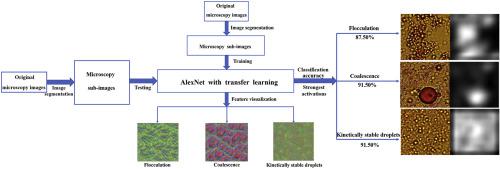当前位置:
X-MOL 学术
›
J. Food Eng.
›
论文详情
Our official English website, www.x-mol.net, welcomes your feedback! (Note: you will need to create a separate account there.)
Identification, classification, and quantification of three physical mechanisms in oil-in-water emulsions using AlexNet with transfer learning
Journal of Food Engineering ( IF 5.5 ) Pub Date : 2021-01-01 , DOI: 10.1016/j.jfoodeng.2020.110220 Tao Lu , Fanqianhui Yu , Changhu Xue , Baokun Han
Journal of Food Engineering ( IF 5.5 ) Pub Date : 2021-01-01 , DOI: 10.1016/j.jfoodeng.2020.110220 Tao Lu , Fanqianhui Yu , Changhu Xue , Baokun Han

|
Abstract Physical mechanisms of emulsion are generally observed by microscopy images and subjectively identified or judged by experimenters. However, results are not scientific or convincing due to the lack of specific qualitative or quantitative indicators. To overcome this drawback, AlexNet with transfer learning was employed to automatically identify, classify, and quantify three different physical mechanisms of emulsions. The proposed network achieved good performance with high classification accuracy, and fast training and testing time. Feature visualization of the last fully connected layer represents the common and high-level features of each mechanism, especially the feature image of coalescence, which clearly shows a large droplet is consisting of two or more merged small droplets. Moreover, information entropy calculated the disorder level in feature images of each mechanism, and strongest activations demonstrated the proposed network learns correct features. Therefore, these results contribute to a better understanding of emulsion science from the perspective of deep learning.
中文翻译:

使用 AlexNet 和迁移学习对水包油乳液中的三种物理机制进行识别、分类和量化
摘要 乳剂的物理机制一般通过显微图像观察,并由实验者主观识别或判断。然而,由于缺乏具体的定性或定量指标,结果并不科学或令人信服。为了克服这个缺点,采用具有迁移学习的 AlexNet 来自动识别、分类和量化乳液的三种不同物理机制。所提出的网络具有良好的性能,具有较高的分类准确率,以及快速的训练和测试时间。最后一个全连接层的特征可视化代表了每个机制的共同和高级特征,特别是聚结的特征图像,它清楚地表明一个大液滴是由两个或更多合并的小液滴组成的。而且,信息熵计算了每种机制的特征图像中的无序程度,最强的激活表明所提出的网络学习了正确的特征。因此,这些结果有助于从深度学习的角度更好地理解乳液科学。
更新日期:2021-01-01
中文翻译:

使用 AlexNet 和迁移学习对水包油乳液中的三种物理机制进行识别、分类和量化
摘要 乳剂的物理机制一般通过显微图像观察,并由实验者主观识别或判断。然而,由于缺乏具体的定性或定量指标,结果并不科学或令人信服。为了克服这个缺点,采用具有迁移学习的 AlexNet 来自动识别、分类和量化乳液的三种不同物理机制。所提出的网络具有良好的性能,具有较高的分类准确率,以及快速的训练和测试时间。最后一个全连接层的特征可视化代表了每个机制的共同和高级特征,特别是聚结的特征图像,它清楚地表明一个大液滴是由两个或更多合并的小液滴组成的。而且,信息熵计算了每种机制的特征图像中的无序程度,最强的激活表明所提出的网络学习了正确的特征。因此,这些结果有助于从深度学习的角度更好地理解乳液科学。



























 京公网安备 11010802027423号
京公网安备 11010802027423号